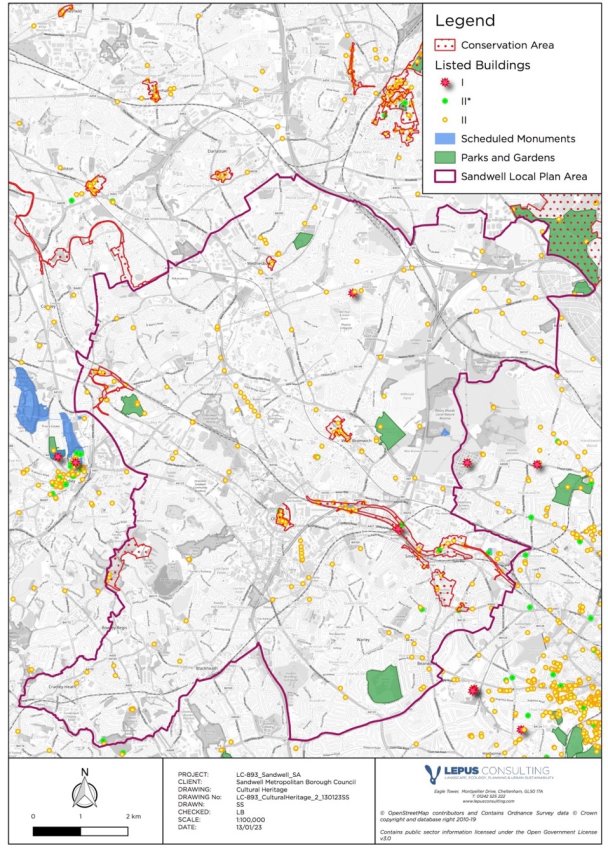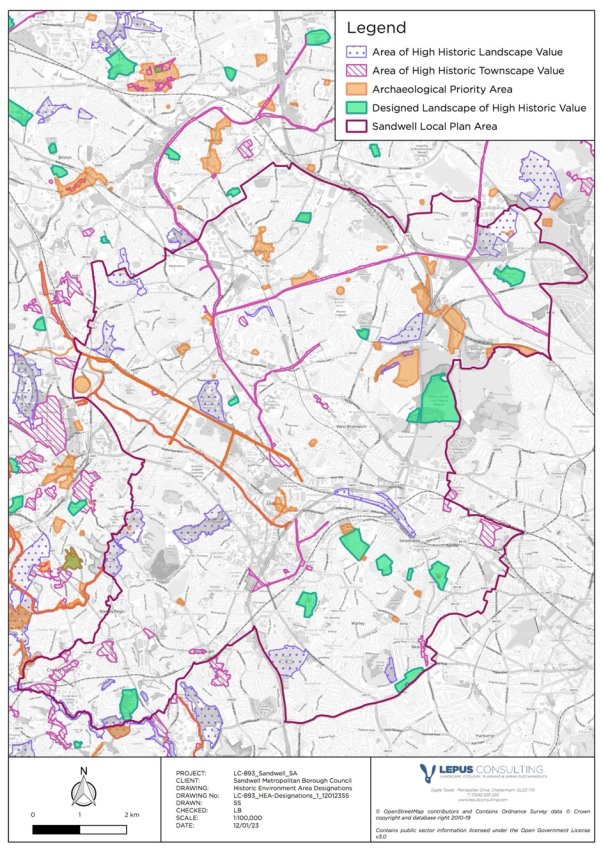Sustainability Appraisal of the Sandwell Local Plan 2024-2041
10 Cultural heritage
10.1 Introduction
10.1.1 Historic environment priorities from the international to local levels seek to address a range of issues, particularly in relation to the conservation and enhancement of heritage assets that are irreplaceable and play an important role in placemaking and the quality of life.
10.1.2 National and local guidance seeks to protect designated assets and their settings, including listed buildings, conservation areas (CAs), scheduled monuments (SMs) and registered parks and gardens (RPGs). Various PPPs seek to ensure that cultural aspects of landscapes are recognised and protected against inappropriate development, encourage recognition of the potential and actual value of unknown and undesignated assets, as well as the conservation and enhancement of sites and landscapes of archaeological and heritage interest so that they may be enjoyed by both present and future generations.
10.1.3 Historic England advocate the seeking of opportunities alongside development for delivering heritage-led regeneration[86], creating, revealing or enhancing local distinctiveness, encouraging the use of traditional building skills, and promoting climate change resilience and innovative reuse of historic buildings where appropriate[87]. The SLP will also have a role to play in establishing cross-cutting provisions relating to development, including between the historic environment and the functionality of open spaces and landscape connectivity.
10.2 Baseline and key issues
10.2.1 Within Sandwell there are four RPGs (plus a section of 'Great Barr Hall, Walsall' RPG), seven SMs, nine CAs, two Grade I Listed Buildings, eight Grade II* Listed Buildings and 195 Grade II Listed Buildings (see Figure 10.1).
10.2.2 Six heritage assets within Sandwell are listed on Historic England's Heritage at Risk register[88]: 'Chances Glassworks, Smethwick' SM; 'High Street, West Bromwich, Black Country' CA; 'Market Place, Wednesbury' CA; 'Great Barr Hall, Walsall' RPG; and the Listed Buildings 'Waterloo Hotel, Shireland Road, Smethwick' and 'Soho Foundry, Foundry Lane, Smethwick'. Local heritage initiatives include the Wednesbury High Street Heritage Action Zone (HSHAZ)[89] funded by Historic England, which seeks to restore, enhance and celebrate Wednesbury's historic town centre including the 'Market Place, Wednesbury' CA. Similar initiatives could be pursued to target improvement of other Heritage at Risk features.

Figure 10.1: Cultural heritage assets in and around the SLP area (source: Historic England)
10.2.3 The Black Country Historic Landscape Characterisation (HLC) Study[90] aimed to create a strategic landscape-level understanding of the historic character and environment of the Black Country, including Sandwell. The study identified several Historic Environment Area Designations (HEADs) within Sandwell's Green Belt and in the urban area. The study also identified a number of Archaeological Priority Areas (APAs), which are considered to contain particularly rare or well-preserved remains of high archaeological and historic interest.
10.2.4 The HLC Study identifies 15 Character Areas within Sandwell. Like the other Black Country authorities, Sandwell has a rich industrial history, and this is reflected in the Character Areas with many aspects dominated by the legacy of mining as well as the canal and rail network, with significant housing growth particularly in the 19th Century.
10.2.5 Areas of High Historic Townscape Value (AHHTVs) and Designed Landscapes of High Historic Value (DLHHVs) have also been identified within the HLC. AHHTVs are areas "where built heritage makes a significant contribution to the local character and distinctiveness" and have been identified due to their sense of place, street plan and form, streetscape, views and setting, and representation. DLHHVs are "designed landscapes that make an important contribution to local historic character but do not meet the criteria for inclusion on the national Register of Parks and Gardens" and have been identified due to the date, preservation, aesthetics, and associations with people and past events. The HEADs including AHHTVs, DLHHVs and APAs are shown on Figure 10.2.
10.2.6 Impacts on heritage assets will be largely determined by the specific layout and design of development proposals. The level of impact will depend on the nature and significance of, and proximity of the proposal to, the heritage asset in question.
10.2.7 Adverse impacts on heritage assets can include direct loss or truncation of an asset, impacts on the existing setting of the asset and the character of the local area, as well as adverse impacts on views of, or from, the asset. These negative impacts are expected to be long-term and irreversible. It is anticipated that the SLP will require a heritage statement and/or an archaeological desk-based assessment to be prepared to accompany future planning applications, where appropriate. This site-specific information will help to better identify and quantify effects, compared to the high-level appraisal that has been possible in the SA process, given the limited information that has been available to inform conclusions with regard to cultural heritage at this stage.

Figure 10.2: Historic Environment Area Designations in the SLP area (source: SMBC)
Key issues for cultural heritage include:
- Development promoted through the emerging SLP may have the potential to cause adverse effects on historic landscapes and lead to damage to archaeological sites, monuments and buildings and / or their settings.
- There are six heritage assets listed on the Heritage at Risk register within the SLP area which should be protected from inappropriate development and require improved management.
- There is a need to promote innovative re-use of existing building stocks. The SLP should seek to improve the energy efficiency of historic buildings and take into account their embodied carbon value when considering their retention and re-use, versus their replacement.
- Archaeological remains, both seen and unseen, have the potential to be adversely affected by new development. The Black Country HLC indicates some rare archaeological features of interest within Sandwell that should be preserved.
10.3 Impacts on cultural heritage
10.3.1 Box 10.1 presents a plan-wide summary of the adverse impacts on cultural heritage that have been identified through the SA process. These adverse impacts are those identified prior to mitigation considerations and for cultural heritage relate primarily to the alteration of historic character and setting associated with designated heritage assets.
Box 10.1: Summary of identified impacts on cultural heritage
Impact on cultural heritage
Summary of identified impact

Alter character and/or setting of designated heritage assets
Development which coincides with or is located in close proximity to heritage assets has the potential to affect both the asset itself and its setting. This will depend on contextual factors relating to the nature and location of development and factors that contribute to the significance of heritage assets, including its setting.
A total of five of allocated sites coincide with Listed Buildings, including SEC3-66 which coincides with Grade II* Listed Building 'Soho Foundry Former Boulton and Watt Foundry Pattern Stores and Erecting Shops', and sites SH7, SH14, SEC3-66 and SM1 which also coincide with Grade II Listed Buildings. The proposed development at 16 further sites in close proximity to Grade II* and Grade II Listed Buildings has the potential to adversely affect their settings.
Conservation Areas (CAs) are identified as areas of architectural or historic interest and designated at a local level. The SA adopts a precautionary approach to the assessment by presuming that development within or in proximity to a CA has the potential to adversely impact the heritage asset and its setting. It is however acknowledged that the replacement of buildings which currently have a detrimental impact on a CA could potentially result in a neutral, mixed or beneficial effect (to be informed by published conservation area appraisals[91] and site assessments).
A total of eight allocated sites coincide with a CA: Site SH7 and SH10 with 'Factory Locks', sites SM1, SH41, and SH54 with 'Smethwick, Galton Valley', SH51 and SM5 with 'High Street West Bromwich', and SH65 with 'High Street and Crocketts Lane'. Development at these eight sites will have potential to affect the character of the CA. A total of six allocated sites are located adjacent (SEC3-148, SEC4-4, SEC3-66 and SH55) or in close proximity (SH37 and SH58) to CAs, all of which would have the potential to affect the setting of the CAs.
Scheduled monuments (SMs) are nationally important archeological sites or historic monuments which require protection to ensure the SM and its setting are conserved and enhanced. Some three sites coincide with SMs, including SEC3-66 which wholly coincides with 'Remains of the Boulton and Watt Soho foundry and mint', SM1 which wholly coincides with 'Chances Glassworks', and SH41 which wholly coincides with 'Smethwick Engine House' and partially coincides with 'Engine Arm Aqueduct'.
Registered parks and gardens are designated heritage landscapes. Development in close proximity to an RPG has the potential to affect both the asset itself and its setting. One allocated site, SEC1-5, lies in close proximity an RPG 'Victoria Park, Tipton'.

Effects on the historic environment
The Black Country Historic Landscape Characterisation (HLC) Study[92] identified a number of Archeological Priority Areas (APAs), where there is high potential for these areas to contain particularly rare or well-preserved remains of high archaeological and historic interest.
A total of three allocated sites including SH7, SH26 and SH33 directly coincide with APAs, and seven further sites lie adjacent to APAs.
Several Areas of High Historic Townscape Value (AHHTVs) and Designed Landscapes of High Historic Value (DLHHVs) were also identified within the Black Country HLC Study are areas or landscapes which make an important contribution to historic character. A total of eight sites coincide with AHHTVs, including sites SEC3-99, SH33, SH34 and SEC3-66 which wholly coincide with AHHTVs, and sites SH7, SH14, SH16 and SM1 where the majority of the site coincides with AHHTVs.
10.4 Local Plan mitigation
10.4.1 The SLP aims to maintain and enhance the natural and historic environment and preserve the local distinctiveness of townscapes and the industrial heritage within Sandwell. The policies anticipated to help conserve and enhance the historic environment and heritage assets are listed in Box 10.2.
Box 10.2: Mitigating effects of the Local Plan policies on cultural heritage
Policy mitigation for cultural heritage
Summary of mitigating effect

Alter character and / or setting of designated heritage assets
Policy SHE1: Listed buildings and conservation areas recognises that listed buildings, RPGs and SMs are an irreplaceable resource. The policy also requires development proposals that would affect a heritage asset to carry out an Assessment of Significance which would inform part of a Design and Access Statement and / or a Heritage Impact Assessment.
Policy SHE2: Development in the historic environment states that heritage assets within the borough will be "retained and, wherever possible, enhanced and their settings respected".
Policy SHE3: Locally listed buildings ensures heritage assets are conserved and enhanced, stating that development proposals affecting locally listed buildings will only be permitted where they "positively contribute towards the significance of the heritage asset and avoid harm".
Policy SDS5: Achieving well-designed places aims to ensure that new development conserves and where possible enhances the setting and significance of heritage assets, demonstrating a "clear understanding of the local and wider context, character, heritage and local distinctiveness".
Effects on the historic environment
Policy SHE1: Listed buildings and conservation areas states that development proposals will be required to "conserve and enhance local character" and those aspects of the historic environment together with their settings.
Policy SHE2: Development in the historic environment states that areas of distinctive heritage within the borough will be "retained and, wherever possible, enhanced and their settings respected".
Policy SHE4: Archaeology states that "development should protect and conserve both designated and non-designated archaeological assets and the character and setting of areas of acknowledged archaeological significance". The policy also requires sites with known archaeological potential to provide an archaeological assessment and / or field evaluation.
Many SLP policies including Policy SDS1: Spatial Strategy for Sandwell and SDS3: Regeneration in Sandwell encourage regeneration and redevelopment of industrial land, town centres and canal corridors with potential opportunities for enhancement of cultural heritage features and historic buildings which can contribute to creating a strong sense of place and celebrating Sandwell's history.
Policy SNE6: Canals recognises the historic, architectural, archaeological and cultural significance of the canal network and will ensure that any development proposals affecting canals will protect and enhance these aspects.
10.5 Residual effects on cultural heritage
10.5.1 The SLP policies seek to mitigate potential adverse impacts on heritage assets due to the proposed development, as well as protect and enhance the townscape character and local distinctiveness of Sandwell, including the historic environment. The residual effects of the proposed allocations on heritage assets are discussed in Box 10.3.
Box 10.3: Residual effects for cultural heritage
Residual effects
Further details of the residual effect
Alter character and / or setting of designated heritage assets
The SLP policies will likely mitigate potential adverse impacts on designated heritage assets which may occur as a result of the development proposed within the SLP, including impacts on listed buildings, CAs, SMs, RPGs and their settings. Adverse impacts on the character or settings of designated heritage assets will likely be mitigated through SLP policies, primarily policies SHE1, SHE2 and SHE3.
A range of legislation, the NPPF and published national and local guidance also affords protection to heritage assets in line with their significance.
The SLP will be expected to mitigate the potential for significant impacts on the designated heritage assets arising from the proposed development sites, and a negligible impact is predicted overall.
Effects on the historic environment
Areas of distinctive heritage including non-designated heritage assets identified within the HLC will likely be mitigated from potential adverse impacts which may occur as a result of the development proposed within the SLP, including impacts on APAs, AHHTVs and DLHHVs. Adverse impacts on historic character will likely be mitigated through SLP policies, primarily policies SHE1, SHE2 and SHE4. The SLP is expected to protect, conserve and enhance historic, architectural and archaeological features, and may lead to longer term benefits to Sandwell's historic environment through encouraging regeneration and redevelopment of industrial land, town centres and canal corridors.
[86]BPF (2017) Heritage Works: A toolkit of best practice in heritage regeneration. Available at: https://bpf.org.uk/our-work/research-and-briefings/heritage-works-a-toolkit-of-best-practice-in-heritage-regeneration/ [Date accessed: 08/07/24]
[87]Historic England (2016) Sustainability Appraisal and Strategic Environmental Assessment – Historic England Advice Note 8. Available at: https://historicengland.org.uk/images-books/publications/sustainability-appraisal-and-strategic-environmental-assessment-advice-note-8/ [Date accessed: 08/07/24]
[88] Historic England (2022) Heritage at Risk Register – Sandwell. Available at: https://historicengland.org.uk/advice/heritage-at-risk/search-register/results/?searchType=HAR&search=sandwell [Date accessed: 08/07/24]
[89] Wednesbury High Street Heritage Action Zone. Available at: https://regeneratingsandwell.co.uk/sandwell_projects/wednesbury-high-street-heritage-action-zone/ [Date accessed: 08/07/24]
[90]Oxford Archaeology (2019) Black Country Historic Landscape Characterisation Study. Available at: https://blackcountryplan.dudley.gov.uk/media/13895/comp_black-country-hlc-final-report-30-10-2019-lr_redacted.pdf [Date accessed: 08/07/24]
[91] SMBC. Conservation Area Appraisals. Available at: https://www.sandwell.gov.uk/planning/historic-environment/3 [Date accessed: 29/08/24]
[92] Oxford Archaeology (2019) Black Country Historic Landscape Characterisation Study. Available at: https://blackcountryplan.dudley.gov.uk/media/13895/comp_black-country-hlc-final-report-30-10-2019-lr_redacted.pdf [Date accessed: 07/08/24]
